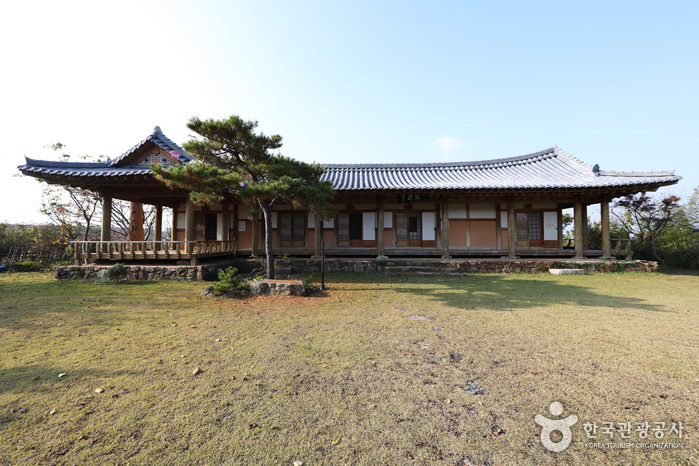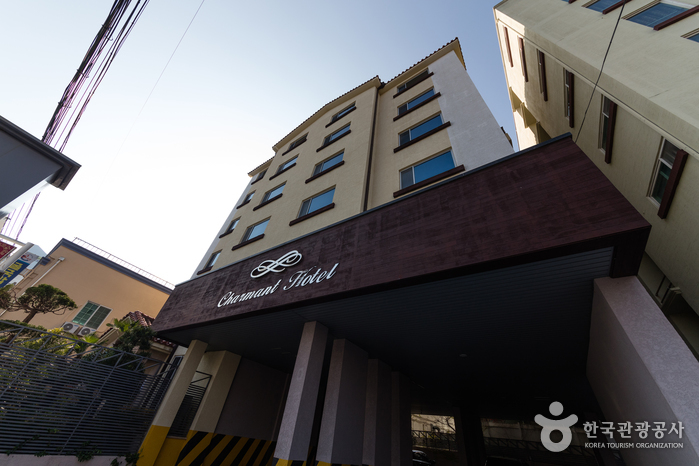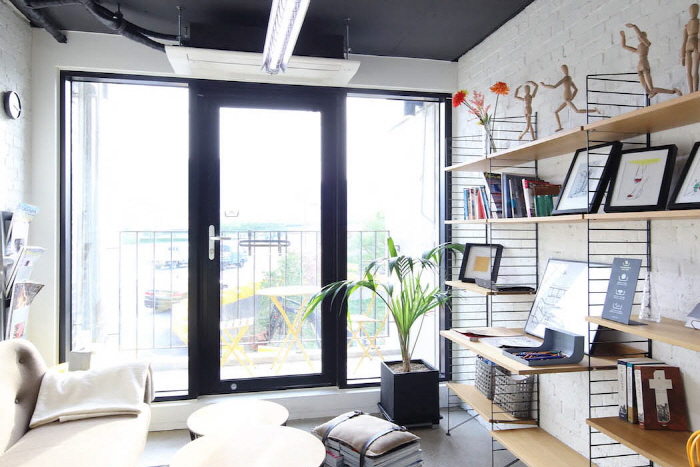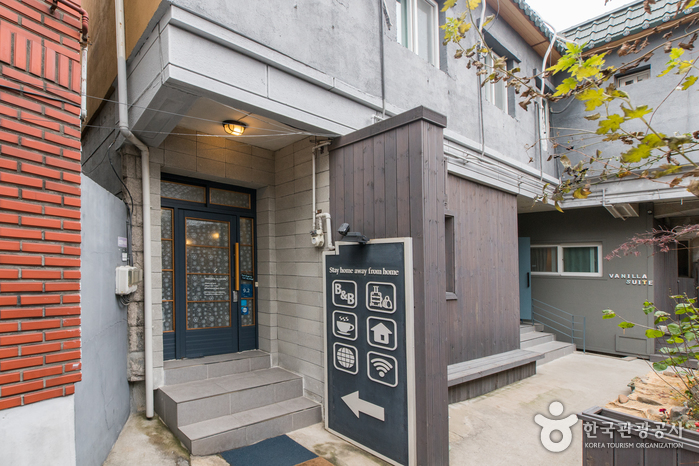Worlindang / 월인당
2025-08-12
37-11, Mojeong 1-gil, Gunseo-myeon, Yeongam-gun, Jeollanam-do
+82-61-471-7675, +82-10-6648-7916
Wolindang is a hanok stay located in “Mojeong Happy Village", Gunseo-myeon, Yeongam-gun. The name “Wolindang” means “The place where the moonlight meets the chimney smoke over the forest" in Korea. It was named as such because the locals make sure the structures are in perfect harmony with the surrounding nature. With comfortable rooms and various things to do in nature, it's a great place to stay for a family vacation. Wolindang is situated on a hill overlooking the plain. There, you will see Wolchulsan Mountain to the east, Eunjeoksan Mountain to the west, and the fields in the northern part of the village. The village is most well known for its beautiful moonlight, particularly when it cascades down from the peak of Wolchulsan Mountain. It's one of the best places in the country to see the full moon throughout the four seasons. Even the guestrooms are named after the natural features of the village, such as “Mountain Sunset” where you can enjoy the beautiful sunset, “Crescent Moon” where you can feel the calm of the moonlight, and "Plain" where you can enjoy a panoramic view of the plains. There are Oriental paintings by Baek Seungdon and Kim Seungnam in each of the rooms, and that's why the rooms are collectively called "The Wolin Museum" among the locals. As you take a walk in the village, you will see many murals, which are the paintings of the 12 different landscape views seen from Wonpungjeong Pavilion at the end of the village. The murals include some poems written by the villagers. In 2005, the owner of this place moved back to this village, his hometown, and built this traditional Korean house in a large vegetable garden right below the house where his family has lived since the time of his great-grandfather. The house has all the features of a traditional Korean house, including the “numaru”, main floored room, flat stone floor, and red clay walls. The “numaru” and “toenmaru” in particular are great places to enjoy the wind and see the clear sky. Guests can enjoy a meal or tea in the "numaru" located next to the “Plain Room”. The flat stone floor is designed for floor heating from the kitchen furnace, just like the rooms in a house were heated in the past. The kitchen furnace can be used as a BBQ or to cook sweet potatoes. The floors in the room are covered with traditional Korean paper and furnished with starched sheets and blankets. There are a number of programs with nature as the theme for the guests to enjoy as well, such as the “Tea Drinking Experience” program where you get to make and drink your own green tea and yellow tea in the traditional Korean way and “Natural Dyeing Experience” where you can dye your own handkerchief or T-shirt using natural materials such as persimmon, safflower, and tree. Other programs include the cooking class where guests get to make knife-cut noodles with adzuki beans and Korean wheat dough. There is a volleyball court in the grass yard. These traditional experience programs and the large grass yard are two of the main reasons why large families choose this place to stay overnight. As such, this is one of the most recommended guesthouses for families with children or old parents planning for a trip.
SUNCHEONMAN TRADITIONAL FOLK PENSION [Korea Quality] / 순천만민속한옥펜션 [한국관광 품질인증]
2023-04-13
33, Daedae 2-gil, Suncheon-si, Jeollanam-do
+82-61-741-6735
Suncheonman Minsok(Folk) Hanok Pension is located on a high plain overlooking Suncheonman Bay Ecological Park. It has been in business since 2012. Because it’s an old house that has been passed down through four generations and it may be uncomfortable for the guests to stay in, the house was renovated with five more guestrooms added in August 2013. The guesthouse was named by the owner's son, because the house has all the features of a traditional Korean house and commands a great view of Suncheonman Bay. The guestrooms are furnished with a modern bathroom, kitchen, TV, and air conditioner, but the floor is made of a thick layer of red clay using the traditional Korean floor heating system, which traps the warmth in the clay for a long time after being heated. The structure is built with Korean pine wood, which is good for your health and smells good too.
Located in the highest part of the village, the place commands a panoramic view of all the rice paddies and reed fields. In early winter, you can also see the migratory birds that are listed as a natural monument and black cranes feeding on the rice paddies. The Suncheonman Bay Ecological Park is only a 10-minute walk from the pension, so you can take a short walk to the park and enjoy the sunset on the Yongsan Observatory there. The natural landscape around the pension is a sight to behold in itself during the daytime, and the night view of the new town is also beautiful during the nighttime. There is a wooden deck in front of the pension where you can enjoy barbecue while taking in the night view. One of the best things about staying at this pension is that you can pick vegetables from the kitchen garden cultivated by the owner and his wife.
One of the reasons why this pension became popular is the food prepared by the owner's wife. Her food was introduced in the popular Korean TV show “Korean Cuisine and Dining” on the KBS channel, which introduced the family food of Jeollanam-do. All the dishes are made of all natural ingredients without any artificial flavors. The food is so good that some guests actually come here just for the food, without staying overnight. They say the dishes are nothing fancy, as all you will get is soup, grilled fish, and seasoned cockles, but they are some of the best you can find in the country. Her rolled omelete made of fertile eggs from the chickens grown by the owner is particularly popular among the regulars. The price for the food is very affordable as well.
Seoladawon [Korea Quality] / 설아다원 [한국관광 품질인증]
2023-04-13
153-21, Samseong-gil, Bugil-myeon, Haenam-gun, Jeollanam-do
+82-61-533-3083, +82-10-7616-6129
Located at the foot of Mt. Duryunsan in Haenam, Jeollanam-do Province, Seola Dawon is committed to preserving and inheriting the tea culture and nature of the region. The owner began to cultivate this place after hearing the concerns about the absence of a person who would inherit the tea culture of this region from a Buddhist monk he met at Iljiam Hermitage of Daeheungsa Temple in Haenam in 1996. Meanwhile, nine young men who studied tea together cultivated the green tea field in Haenam and built houses. After that, people who had affection for teas began to visit Seola Dawon. Since there were no decent accommodations for people who came from afar, they built eight Korean traditional-style houses in all including a Sarangbang made with stones, the earthen house, the wall-frame house, and the earthen bag house. The Korean traditional-style house was built in 2003 as a cultural space and later remodeled into rooms for the operation of Hanok Stay.
Charmant Hotel / 샤르망 호텔
2025-08-11
5, Sinheung-ro 59beon-gil, Mokpo-si, Jeollanam-do
+82-10-6433-2199
Charman Hotel is located in the downtown area of Sang-dong, Mokpo, Jeollanam-do, frequented mostly by business travelers on weekdays and families on weekends. Because of this, the hotel has 10 Family Rooms to accommodate families visiting the area. It's in a quiet neighborhood with lots of restaurants to choose from. There is also a park right in front of the hotel for a morning walk, and Gatbawi Rock and Peace Square are great places to tour and take a walk since both are within a 10-minute walk from the hotel. Yudalsan Mountain is a 15-minute ride from the hotel, and Gohado Island and Samhakdo Island are both near the hotel. For families, there are the National Research Instiute of Maritime Cultural Heritage and Mokpo Natural History Museum.
BAGUNIHOSTEL
2021-04-09
4, Yeokjeon 2-gil, Suncheon-si, Jeollanam-do
Baguni Hostel is a beautiful architecture with stylish design and interior that are pleasing to the eye. Each of the furniture and decor is carefully selected by an interior designer. Created by a florist, the garden is in perfect harmony with the surrounding nature. This environment-friendly structure ranked high in the Japanese comprehensive evaluation and commendation system “Good Design Award 2017.” Suncheonman Bay and Suncheonman National Bay Garden are approximately a 15-minute ride from the hostel, which is one of the reasons majority of the guests who frequent the hostel are in their twenties and thirties. Upon check-in, guests are given special coins that can be used to avail themselves of various rental services, pay for breakfast, toiletries, coffee, and draft beer, and rent a bicycle.
Nogodan Guesthose [Korea Quality] / (주)제이디에치(노고단 게스트하우스&호텔) [한국관광 품질인증]
2023-04-13
40, Hagwan 1-gil Sandong-myeon, Gurye-gun, Jeollanam-do
+82-10-5477-6288
Nogodan Guesthouse & Hotel in Gwansan-ri, Gurye-gun, Jeollanam-do offers a panoramic view of Jirisan Mountain. Majority of the guests are families who visit the area for the hiking trail called Gurye Dullegil during weekends or vacation. One of the most outstanding features of this guesthouse is that it supplies hot spring water containing germanium, so guests can relax in a bathtub filled with hot spring water after hiking. The guesthouse also has a rooftop garden from which you can enjoy the landscape of Jirisan Mountain. There is a bus going to Nogodan Peak, and a round-trip ticket costs KRW 15,000. Note, however, that the bus doesn't run during winter, so it's the best time of the year for serious hikers who prefer walking rather than taking a bus. The owner of the guesthouse sometimes serves as mountain guide upon the request of his guests. And Located on the ground floor of Nogodan Guesthouse, BUEN CAMINO is a restaurant & pub for travelers. Dishes are cooked to order, with ingredients produced in Gurye near Mt. Jirisan. Seasonal vegetables and side dishes are served with the following main dishes: Jirisan Black Pork BBQ, Jirisan Zucchini Stew, and Jirisan Pan-dried Zucchini. It is possible to order for one person for every item on the menu. If you are going to have Jirisan Black Pork BBQ, you'd better make a reservation in advance so that you can save time and enjoy the meal in a more pleasant and comfortable atmosphere. Sansuyu Makgeolli goes well with all the dishes served.
Sane Flower [Korea Quality] / (주)산에는 꽃이피네 [한국관광 품질인증]
2020-09-03
20-1, Dongnyeok-gil, Dado-myeon, Naju-si, Jeollanam-do
+82-10-4612-4232
‘Flowers Blossoms in the Mountains’ is a hanok-style accommodation located between the House of Hong Gi-chang, a local cultural heritage, and Gyeeun Historic House (or the House of Hong Gi-eung; National Folklore Cultural Heritage No. 151) in Dorae Hanok Village. Built in 1917, the house was built with carefully selected high-quality wooden materials without using nails. It was renovated for use as tourist accommodation in 2011, opened as a hanok style of accommodation in 2013, and renovated again in 2014. On this occasion, the old doors were replaced and made into the tables that stand in the grassy courtyard.
The house has a total of 4 rooms. Each room can accommodate up to 2 to 4 people. Each room is equipped with a kitchen, bathroom, air-conditioner, TV, toiletries, plates, and so on.
This well-insulated hanok house is decorated with hanji (traditional Korean paper handmade from mulberry tree) and various antique items. Tables are available for guests in the courtyard, of which a stylish stone-paved corner stands out in particular.
There is a walkway established by Naju City in front of the house, and a vegetable garden near the house. Guests can see gourds and sponge gourds in the yard and acorn trees on the hill behind the house. In addition, the Metasequoia Street that runs through the grounds of the Naju Forest Resource Institute is just one minute’s drive from the house.
Moreover, as the village contains many houses that are classed as cultural heritages, the owner guides guests around them at weekends. Surrounding tourist attractions include Bulhoesa Temple and Najuhyanggyo Confucian School.
Eoryeondang [Korea Quality] / 어련당 [한국관광 품질인증]
2020-12-12
61, Sanjeon-gil, Jung-gu, Ulsan
+82-52-297-5796
Located in Jung-gu, Ulsan City and built and operated by Jung-gu Office, Eoryeondan Guesthouse was opened in August 2014 to offer guests an opportunity to enjoy a hanok stay and various traditional Korean experiences. The house was named ‘Eoryeondang,’ meaning a “house abounding with beautiful words,” after Eoryeoncheon Stream (previously Dongcheon Stream).’ This two-story hanok building was built with granite construction materials including the staircases, fence, and external pillars, creating a solid and majestic impression. Located next to the house is Sanjeonsaem Spring, which was found over 400 years ago and used to supply the house with drinking water, but it was transformed into a garden after the spring ran dry. Eoryeondang has seven guestrooms all together, including three rooms (26m2) equipped with a sink, another three rooms (26m2 each) without a sink, and one room (about 39㎡) equipped with a maru (wooden floor). In particular, the large room, Eoryeonjae, is recommended for family guests. Six of the rooms - Yi, Ho, Ye, Byeong, Hyeong and Gong - were named after administrative agencies of the Joseon Dynasty. Each room can accommodate from 4 to 6 people and is equipped with a bathroom, TV, air-conditioner, refrigerator, Wi-Fi, etc. Set amid an attractive natural environment including pine and bamboo trees, the house is characterized by its interesting ceilings, including the ‘井’-shaped ceiling on the first floor, and the exposed rafters on the second floor. The house is mainly built of pine wood, and each room is decorated with a traditional style of floor paper using beans and hanji (traditional Korean paper handmade from mulberry tree) wallpaper. The house is adjacent to various interesting sites including the Military Headquarters of Gyeongsangjwa-do Province (Historic Site No. 320), where the military governor of Gyeongsangjwa-do used to stay; an elliptical fortress built in 1417, with a circumference of 1.2km and walls about 3.7meters high; Oesol Memorial Hall, which is a Hangeul museum; and Dongcheon Water Park. It also offers guests the opportunity to play various folk games including yut (a Korean traditional board game), tuho (stick throwing), jegichagi (Korean shuttlecock game). The house makes continuous efforts to improve its services by surveying its guests and reflecting their opinions accordingly.
Hostel Vanilla2
2021-04-09
34-8, Jong-ro 57-gil, Jongno-gu, Seoul
+82-10-9945-1944
Hostel Vanilla 2 is a guesthouse in a residential house located in Sungin-dong, Jongno-gu, Seoul. The 2-story house has 9 cozy rooms. Over 90% of the guests are from China, Taiwan, Hong Kong, Thailand, and Japan, and most of them are in their twenties. Since it is within a 10-minute walk from Dongdaemun Design Plaza, most guests – particularly those who came to Korea to shop during their tour - stay there for three or four days. All the guestrooms are for two and are kept clean at all times. The guesthouse provides free luggage storage service even after the guest has checked out, which is very convenient to the shoppers. Because the guests are young, the guesthouse owner communicates with the guests through various social network services and apps.
The House of Yehbon [Korea Quality] / 예본의 집 [한국관광 품질인증]
2020-09-03
1 FL, 64, Gaepo-ro 118-gil, Gangnam-gu, Seoul
+82-10-3908-1617, I have a what's app.
The house of Yehbon(예본의 집) is a guesthouse in a single-story residential house. The owner of the guesthouse has stayed at many guesthouses in the US while traveling and loved how they decorated the rooms according to the unique characteristics of the region. This is why she furnished the rooms with a traditional Korean cabinet inlaid with mother-of-pearl and other furniture that are more than 100 years old and covered with mantles that she herself embroidered. The antique furniture is one of the outstanding features of this guesthouse, which has two guestrooms, living room, kitchen, and two bathrooms. Many guests are from India, Canada, America, Netherlands, and Russia, including Koreans living abroad, and they say they find this place very comfortable. It's like homestay, but the owner of the guesthouse tries to provide enough privacy for those who wish to be left alone as well. It’s very conveniently located in Gangnam with access to public transportation within the vicinity and close to the subway station(3rd Daecheong station).
I give my guests space but I am available when needed. Privacy is protected. You can always communicate with the host. The guests stay in the 1st floor, and the host lives in the 2nd floor. You can cook and enjoy a meal together in a spacious kitchen. You can take a shower but no bathtub in the bathrooms. It's very easy to find my place. Parking: Just next to the gate. (20 steps) There're a lot of delicious inexpensive restaurants and a CU convenience store just in front of the house.

![SUNCHEONMAN TRADITIONAL FOLK PENSION [Korea Quality] / 순천만민속한옥펜션 [한국관광 품질인증]](http://tong.visitkorea.or.kr/cms/resource/28/2632328_image2_1.jpg)
![Seoladawon [Korea Quality] / 설아다원 [한국관광 품질인증]](http://tong.visitkorea.or.kr/cms/resource/63/2584863_image2_1.jpg)


![Sane Flower [Korea Quality] / (주)산에는 꽃이피네 [한국관광 품질인증]](http://tong.visitkorea.or.kr/cms/resource/98/2574998_image2_1.jpg)
![Eoryeondang [Korea Quality] / 어련당 [한국관광 품질인증]](http://tong.visitkorea.or.kr/cms/resource/85/2050185_image2_1.jpg)

![The House of Yehbon [Korea Quality] / 예본의 집 [한국관광 품질인증]](http://tong.visitkorea.or.kr/cms/resource/08/2557408_image2_1.jpg)
 Français
Français
 한국어
한국어 English
English 日本語
日本語 中文(简体)
中文(简体) Deutsch
Deutsch Español
Español Русский
Русский